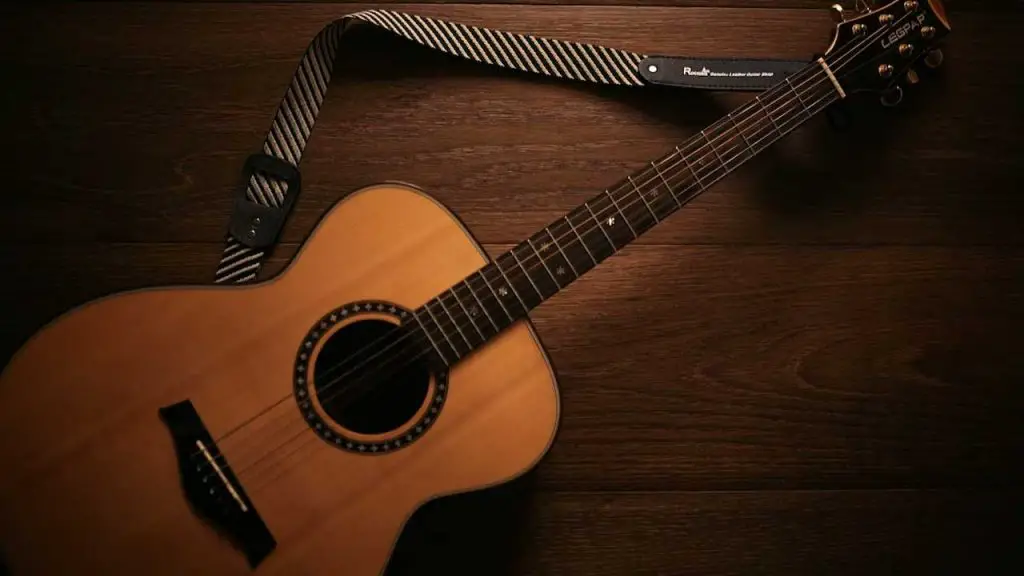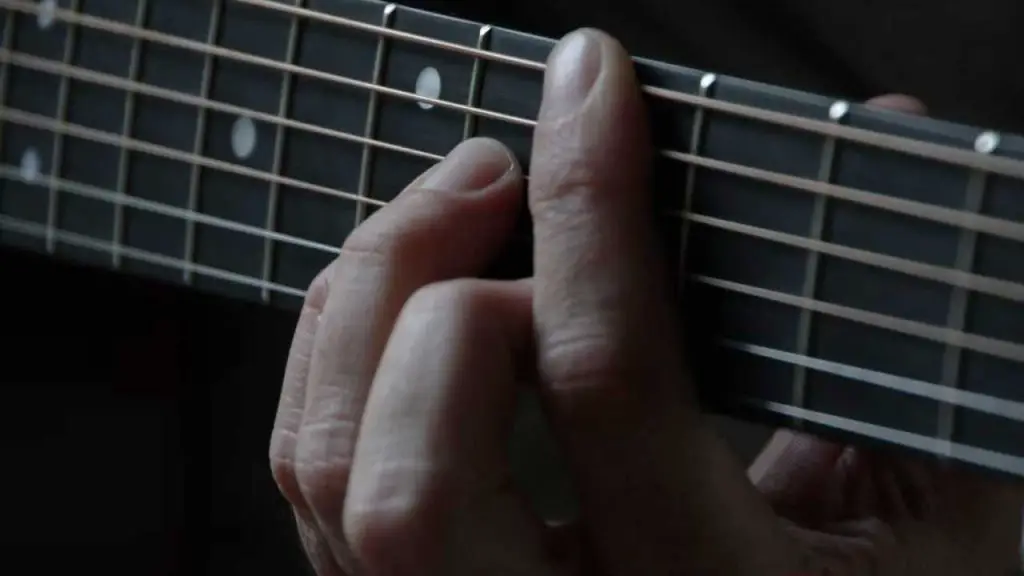Folkstrings.com is reader-supported. When you buy through links on our site, we may earn a small commission.
Learning to play the blues on guitar is a journey that combines technical skills with a heavy dose of musical expression.
The blues, with its rich history and profound impact on modern music, offers guitarists a way to develop their playing by exploring a genre that’s both foundational and deeply emotional.
As someone who’s walked this path, I can attest to the transformative power of understanding and playing the blues. It’s about more than just learning scales and patterns; it’s about telling a story with every note.

When I began learning blues guitar, I found that it was as much about feeling as it was about technique.
Mastering the blues scales was an essential first step, providing the vocabulary needed to express the soulful nuances of the genre.
I also discovered that the rhythmic grooves and patterns of blues are the backbone of its iconic sound, requiring a solid sense of timing and groove.
As my journey unfolded, I explored various expressive techniques and dynamics, such as bends, vibrato, and the delicate art of timing, all of which brought my playing to life in a way that notes on a page never could.
Key Points
- Learning blues on guitar is an expressive journey that extends beyond just technical skills.
- Mastering blues scales and understanding rhythmic patterns is fundamental to blues guitar playing.
- Studying the techniques and styles of blues masters enhances personal expression and deepens musicality.
Getting Started with Blues Guitar
When I picked up my first guitar, the allure of blues music with its soulful and dynamic nature drew me in. Let me guide you through the essentials you need to delve into the world of blues guitar.
Understanding Guitar Fundamentals
Before I get into the blues specifics, it’s crucial to have a grasp of guitar fundamentals.
I ensure my guitar is properly tuned. The standard tuning from the lowest (thickest) string to the highest (thinnest) string is E-A-D-G-B-e.
I find it’s helpful to develop a warm-up routine that involves practicing scales, finger dexterity exercises, and strumming patterns.
Next, I familiarize myself with the fretboard. Knowing which notes are where makes navigating chords and scales much simpler. I usually start with the pentatonic scale as it’s the backbone of many blues solos and melodies.
Basic Blues Chords and Progressions
The foundation of blues rhythm guitar is understanding chords and chord progressions. Here’s a basic blues progression I started with, known as the I-IV-V progression, using chords in the key of E:
| Chord | E (I) | A (IV) | B (V) |
|---|---|---|---|
| Bars | 4 | 2 | 2 |
I begin practicing this with simple, open E, A, and B7 chords.
The numbers (I, IV, V) refer to the first, fourth, and fifth degrees of the E major scale which form the basis of the progression. This is an essential pattern I’ve learned and it recurs frequently in blues music.
By strumming these chords with a steady rhythm and incorporating a shuffle or swing feel, the characteristic blues sound starts to come through.
Mastering Blues Scales
Understanding and mastering blues scales is crucial for any guitarist looking to play blues music. These scales form the foundation of blues solos and improvisation, allowing you to express emotions and create your own unique sound.
Pentatonic and Blues Scale Essentials
The pentatonic scale is a five-note scale that serves as the backbone for blues improvisation. In blues, we primarily use the minor pentatonic scale, which for example, in the key of A, consists of the following notes:
A (Root) – C (Minor third) – D (Perfect fourth) – E (Perfect fifth) – G (Minor seventh)
To turn the minor pentatonic into the blues scale, I add a flattened fifth, known as the “blue note.” In the key of A, the blue note is E♭. This note gives the blues its distinctive sound. Here’s how the A blues scale looks:
A (Root) – C (Minor third) – D (Perfect fourth) – E♭ (Blue note) – E (Perfect fifth) – G (Minor seventh)
Incorporating Scales into Solos
When it comes to solos, I think of scales not just as a sequence of notes, but as a palette to paint with. To create impactful solos, I blend notes from these scales with expressive guitar techniques like bends, vibratos, and slides.
- Bends: Striking a note and then bending the string to reach the pitch of another scale note.
- Vibratos: Slightly and rapidly bending the string back and forth to add warmth to the note.
- Slides: Gliding the finger from one fret to another to connect scale notes seamlessly.
My approach is always to prioritize feeling and phrasing over technical complexity. By using the minor pentatonic and blues scales thoughtfully, I can convey the emotive quality that defines blues guitar.
Rhythmic Grooves and Patterns
Mastering rhythmic grooves and patterns is crucial for playing blues on guitar. I’ll cover the essentials of the 12-bar blues rhythm and explore various time signatures and grooves to give your blues that authentic feel.
12-Bar Blues Rhythm
The 12-bar blues is a common pattern used in blues music that forms the foundation for many songs. When I play the 12-bar blues, I cycle through a specific chord progression that typically follows the I-IV-V chord pattern over twelve measures. Here’s a basic example in the key of A:
| Measure | Chord |
|---|---|
| 1-4 | A7 |
| 5-6 | D7 |
| 7-8 | A7 |
| 9 | E7 |
| 10 | D7 |
| 11 | A7 |
| 12 | E7 |
Each chord indicates where I change my strumming or picking pattern to fit the chord’s rhythm.
By keeping my strumming hand consistent and allowing for slight variations in attack and dynamics, the groove stays deep and compelling.
Playing with Time Signatures and Grooves
While the majority of blues music is in 4/4 time, having the versatility to play in various time signatures can make my playing stand out.
A time signature like 12/8 can give a song a swing feel, which is an integral aspect of many classic blues numbers. When I play with the groove, I focus on the downbeats and backbeats while practicing keeping a steady tempo.
To maintain a strong rhythmic foundation, here’s how I count out a 12/8 blues pattern:
- 1 (downbeat) – two – three – 4 (backbeat) – five – six – 7 (downbeat) – eight – nine – 10 (backbeat) – eleven – twelve
It’s important to note that, when playing blues, the strength is often in the subtlety of the rhythm. I make sure that my groove has a feeling of forward motion and a sense of swing, even if it’s understated.
Expressive Techniques and Dynamics
When learning blues guitar, mastering expressive techniques like string bending and vibrato, along with slides, hammer-ons, and pull-offs, is crucial. They add emotion and depth, accentuating the soulful essence of the blues.
String Bending and Vibrato
I find that string bending is a key element in blues music. It involves physically pushing or pulling a string to raise the pitch. This can express yearning or intensity in my playing.
Meanwhile, vibrato adds a rich, quivering texture to notes, which I achieve by oscillating the pitch of a note.
These techniques require precise control over finger strength and movement for the desired expressiveness.
- String Bends: Reach for the note above your target pitch, then bend the string up to meet it.
- Vibrato: Use wrist movement to create a rapid, small pitch variation, keeping it even and controlled.
Slides, Hammer-Ons, and Pull-Offs
Slides allow me to move smoothly between notes by maintaining pressure on a string as I slide my finger up or down the fretboard.
Hammer-ons and pull-offs are subtle yet powerful ways to add nuance to my phrasing.
With a hammer-on, I sharply press my finger onto the fretboard, sounding a higher note. For a pull-off, I pluck the string with my fingertip while removing it from the fretboard to sound a lower note.
- Slides: Perform with a fluid motion to connect notes legato-style.
- Hammer-Ons: Snap the finger down onto the fretboard to sound the note.
- Pull-Offs: Flick the string with a pulling-away motion to let the lower note ring out.
Through these dynamic techniques, my blues guitar playing becomes more expressive, evoking the rich emotional palette the genre is known for.
Learning from the Blues Masters
Mastering blues guitar means paying homage to the greats who paved the road before us. I find that intimately exploring the techniques and styles of legendary blues guitarists can transform one’s own playing from mere imitation to deeply felt expression.
Influence of Legends and Their Styles
I’m constantly amazed by the unique styles of blues legends like B.B. King, whose expressive vibrato and singing guitar lines taught me the importance of phrasing. Muddy Waters introduced me to the raw power of slide guitar, and the haunting simplicity in Robert Johnson’s playing shed light on the roots of the genre. Each guitarist brought their personal touch to the blues, creating a sonic palette that’s rich for study.
- Stevie Ray Vaughan: His heavy use of string bending and energetic vibrato.
- Eric Clapton: A blend of major and minor pentatonic scales, yielding his signature soulful sound.
Incorporating Licks and Phrases into Your Own Playing
When I began incorporating licks and phrases from these masters into my playing, I noticed a substantial shift. Executing a bend just like B.B. King or mimicking Clapton’s smooth transitions between scales adds authenticity to my playing.
Remembering to not just copy, but to interpret their solos, helps me develop my own voice on the guitar. My advice is to:
- Learn a lick note-for-note.
- Practice it over a backing track in different keys.
- Modify it to fit your own style.
By dissecting the approaches of these instructors and guitarists, I’m not only preserving their legacies but also cementing the foundations of my blues language.
Frequently Asked Questions
I’ve compiled some of the most common questions that budding guitarists ask when they’re starting out with the blues.
Here you’ll find answers that will help you begin your journey into the soulful world of blues guitar.
What are some simple blues songs to start with for guitar beginners?
Which guitar is best suited for a beginner looking to play the blues?
Can you recommend some fundamental blues chords for starting guitarists?
How can I learn to play the blues on an acoustic guitar?
Where can I find beginner-friendly lessons on playing blues on an electric guitar?
What are the key elements of a 12-bar blues progression?
Author Profile
-
Daniel Johnstone is an English writer with a love for stringed instruments from around the world.
He shares his love for these instruments through his writing for folkstrings.com, a website dedicated to all things related to folk string music.
Daniel's passion for music started at a young age, and he has since become an accomplished musician, playing guitar, cavaco, and recently, the harp.
His dedication to learning and sharing his knowledge of stringed instruments is evident in his insightful and engaging blog posts. Whether you're a seasoned musician or a beginner, Daniel's writing is sure to inspire and entertain you.
When he's not playing music or writing, you can find Daniel exploring new instruments and seeking out new sounds to share with his readers.
Latest entries
 AutoharpApril 4, 2024Is Autoharp Easy to Play? Unveiling the Truth for Beginners
AutoharpApril 4, 2024Is Autoharp Easy to Play? Unveiling the Truth for Beginners AutoharpApril 4, 2024What Is an Autoharp Worth? Your Guide to Pricing and Value
AutoharpApril 4, 2024What Is an Autoharp Worth? Your Guide to Pricing and Value AutoharpApril 4, 2024Where Is the Best Place to Buy an Autoharp? Your Top Picks Reviewed
AutoharpApril 4, 2024Where Is the Best Place to Buy an Autoharp? Your Top Picks Reviewed AutoharpApril 4, 2024How Does the Autoharp Work? – Unveiling Its Melodic Secrets
AutoharpApril 4, 2024How Does the Autoharp Work? – Unveiling Its Melodic Secrets



